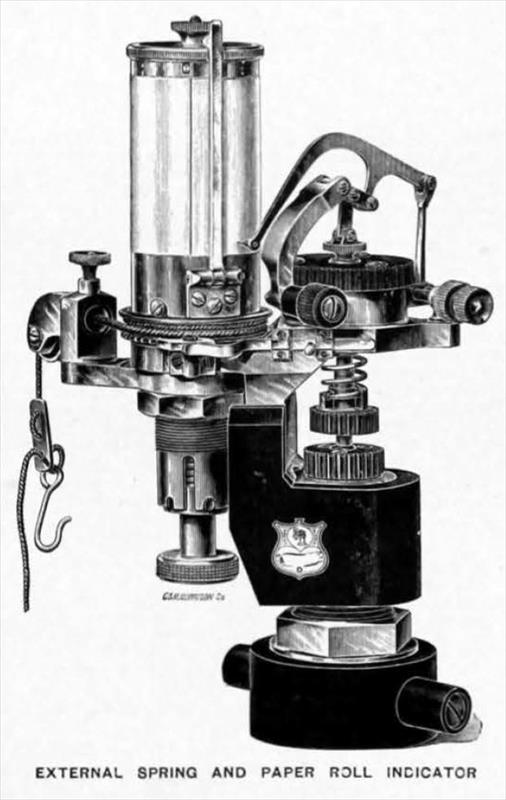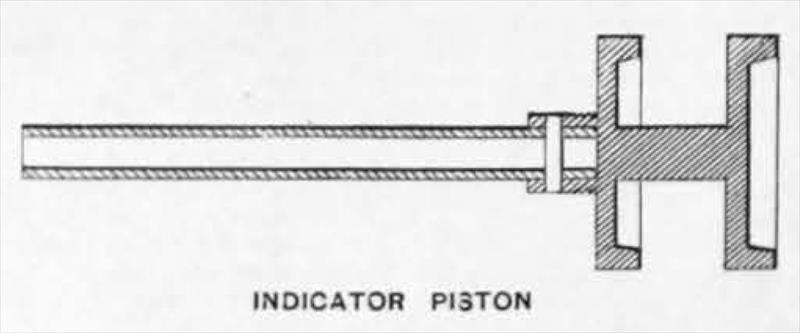|
Title: |
1900 Article-Dobbie-McInnes, Ltd., Steam Engine Indicator |
|
Source: |
The Engineer, V90, 16 Nov 1900, pg. 502 |
|
Insert Date: |
8/1/2017 8:43:42 PM |
Few engineers use indicators without complaining. We have already directed attention to this matter. We do not now refer to the defects, or alleged defects, of it as an instrument of precision, but as to its unhandiness. and the difficulties of using it. We mention one or two points. It becomes so hot that it cannot he handled; the drain hole is so arranged that scalding the hands and face of the operator or his assistant is very easily managed; the cone is apt to stick; putting the paper on the drum is far from being a labour of love; hooking on the line does not promote good temper, although it is not to be denied that the use of an indicator on a fast-running engine in a hot cramped engine-room is calculated to develop Christian fortitude and the restraint of the temper.
The indicator like the one we illustrate has been designed to get over some of these objections. The cylinder is sheathed in a special vulcanite which will not crack, and, being at non-conductor, permits handling without burning. A small tube is fitted to the drain hole, and clip gear is used to hold the paper on the drum. All these things are meritorious.
We illustrate one of the most recent forms of this indicator, which deserves a somewhat detailed description. It is matter of common knowledge that the momentum of the moving parts tends to falsify the diagram. and to get over this difficulty they are made as light as may be in all modern indicators. There is reason, however, to believe that in securing lightness the pencil gear is made so weak that the instrument will not stand the rough work of the engine-room. The best way of overcoming this difficulty, hitherto adopted. has consisted in suppressing the parallel motion levers of the Richard's indicators and securing the straight-line motion of the pencil by a fixed slotted guide. To this there is the objection, that friction will tend to retard the motion of the pencil and reduce the size of the diagram. In the Mclnnes-Dobbie indicator the same end is attained by making the travel of the piston small. The parallel motion is light, but is strong and suitable for everyday use. At the pencil point the travel of the piston is multiplied six times, which is more than in any other indicator. This enables large diagrams to be taken with a comparatively small piston travel and short spring, and tends to greater accuracy. The large diagrams to be taken with a comparatively small piston travel and short spring, and tends to greater accuracy. The bearing surfaces of the motion links are broad. and the whole motion is designed to work in the one central plane, the pencil arm being hung directly over the piston-rod. The piston in of a novel design, being composed of two flanged discs turned with the rod itself from a solid piece of metal. This arrangement prevents sticking and reduces friction caused by the presence of grit, which can find room between the pieces. It is case-hardened and is not appreciably affected by high-pressure steam, and obviates the trouble caused by the ordinary shaped gun-metal piston binding through expansion. The paper drum clip consists of two hinged bars moving independently of each other, and springing into an overlapping catch or spring projecting from the top of the drum. By this means the diagram cards are conveniently and quickly fixed to and removed from the drum, and in the event of the cards being wet there is no danger of their being torn. One form of the instrument is fitted with a drum from a continuous roll of paper for indicating at high speeds and in awkward positions, when it is difficult to fit single sheets for every diagram required.
The drum springs are of the spiral type, and are fit with brass ends. They can be instantaneously adjusted to suit the speed of the engine.
The recent adoption of high-pressure steam in this country and the growing employment of superheated steam abroad has brought into prominence the necessity of keeping the spring cool. In not a few cases the springs inside the indicator are exposed to a temperature of 600 deg., and it has been found practically impossible to make springs which will give correct results at 300 deg. and 600 deg. and intermediate temperatures. The use of steam with a temperature as high as 600 deg. is by no means confined to the Continent. There are engines in this country which have been running for considerable periods with steam superheated to this temperature.
Unfortunately, the loss of strength in a spring does not appear to bear any definite relation to the temperature, and 600 deg. is not far from the heat at which the temper of the spring will be drawn. To overcome this objection in the indicator, which we illustrate, the spring is ?tted outside the cylinder in a way which will be understood in a moment from the engraving. Matters are so arranged that the spring, piston, and parallel motion, that by unscrewing two vulcanite-covered caps, can be withdrawn bodily from the cylinder for inspection, cleaning, adjustment, or the changing of the spring.
The instrument is well made, and great care seems to be taken with the calibration of the springs. It is made by T. S. Mclnnes and Co., Clyde-place, Glasgow. |
|
 1900 Dobbie-McInnes, Ltd., Steam Engine Indicator
1900 Dobbie-McInnes, Ltd., Steam Engine Indicator
 1900 Dobbie-McInnes, Ltd., Steam Engine Indicator Piston
1900 Dobbie-McInnes, Ltd., Steam Engine Indicator Piston
|
|